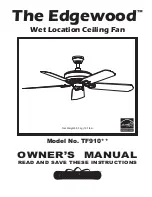
3.6 Electrical connection
Before any maintenance or installation work or before opening the terminal compartment, the device is to
be fully isolated from the power supply and secured against unintended restart!
– The regulations to avoid danger of ignition due to electrostatic discharges (TRGS 727) must be implemented.
– The electrical connection must be carried out only by a qualified electrician in accordance with the data in
the Ex motor terminal box and enclosed wiring diagrams.
– The relevant standards and safety regulations (e.g. DIN VDE 0100) and the technical connection conditions of the
energy suppliers are strictly to be observed.
– An all-pole mains switch / isolator switch with at least 3 mm contact opening is mandatory.
– Every motor must have an
approved PTC-resistor trip device
of category II (2)G, see EU Directive 2014/34/
EU ( Equipment Safety Act), with a reset lock so that there is no automatic resetting after a loss of con-
trol voltage and voltage restoration. Please observe the special regulations accompanying these units.
– Electrical connection data must correspond to the data on the motor type plate.
– The installation of the power cable is to be carried out professionally! The connecting cable must not touch sharp
objects.
– Only explosion-proof cable glands may be used for cable entries and connections!
– Security components, e.g. safety grille may not be dismantled, bypassed or disabled.
– Further operations see the following section “Commissioning”.
– Ground connections, including any supplementary equipotential bonding must be properly installed!
3.7 Commissioning
The following checks are carried out before initial operation:
– check for operation according to the intended purpose of the fan.
– compare power supply voltage with data on the rating plate.
– check fan for solid fastening and professional electrical installation.
– check all parts especially screws, nuts and safety grille for tight fit. Without loosening screws!
– Remove assembly residues from fan and duct.
– test unhindered running of impeller and minimum air gap.
– check if direction of rotation and air flow direction correspond. Check direction of rotation of impeller (by switching
on for a short time; when checking the direction of rotation wear protective goggles.
– compare current consumption with data on the rating plate.
– test functioning of motor protection device.
– test protective conductor connection.
– check sealing of the connection cable and tight clamp of cable wires.
– start operation only if a protection against accidental contact is guaranteed.
– check tightness of all connections (if required).
– during the test run check the fan on improper vibration and noise.
– do not operate the fan beyond the specified performance curve (see catalogue / internet).
the fan must run on its prescribed operating point.
– fill out the enclosed commissioning report (see chapter 7) and submit in case of warranty claim.
3.8 Operation
Regularly check the correct function of the fan:
– unhindered running of impeller.
– check the air gap (see table 3.2).
– measure current consumption.
– check on possible vibrations and noise.
– deposits of dust and dirt in the casing or on the motor and impeller
4.0 Inspection and maintenance
–
Before any maintenance or inspection work or before opening the terminal compartment, the device is to
be fully isolated from the power supply and secured against unintended restart!
– Excessive deposits of dirt, dust, grease and other materials on the impeller, motor and safety grille especially
between casing and impeller is to be avoided and has to be prevented by periodical cleaning.
– The suction-side intake of rust particles (iron oxide) must be prevented. In this respect, the fan must be
checked for any rust film that could settle on the motor or impeller and thus create an ignitable surface by
regular inspection. A six-monthly inspection is required to remove any adhesions.
The inspection intervals are
to be determined by the operator based on usage and carried out during re-commissioning in cases of long periods
of standstill.
– Inspection and maintenance work may only be carried out by ex-authorised specialists.
– Please check:
• Air gap
• Screw connections, particularly impeller fastening.
Without loosening screws!
• Surfaces (e.g. for rust, paintwork damage)
• Bearing noises
• Damages
• Oscillation, vibrations
• Deposits of dirt
• Current consumption
• Function of the safety components
ATTENTION
m
CHAPTER 4
INSPECTION AND
MAINTENANCE
WARNING
m
5
RD..
and VD..
– Roof fans
Installation and Operating Instructions
EN
Содержание RDD 200/4 EX
Страница 14: ...12 RD und VD Dachventilatoren Montage und Betriebsvorschrift DE...
Страница 15: ...13 RD und VD Dachventilatoren Montage und Betriebsvorschrift Notizen DE...
Страница 28: ...12 RD and VD Roof fans Installation and Operating Instructions EN...
Страница 29: ...13 RD and VD Roof fans Installation and Operating Instructions Notes EN...
Страница 30: ...14 RD and VD Roof fans Installation and Operating Instructions Notes...
Страница 31: ...15 RD and VD Roof fans Installation and Operating Instructions Notes...












































